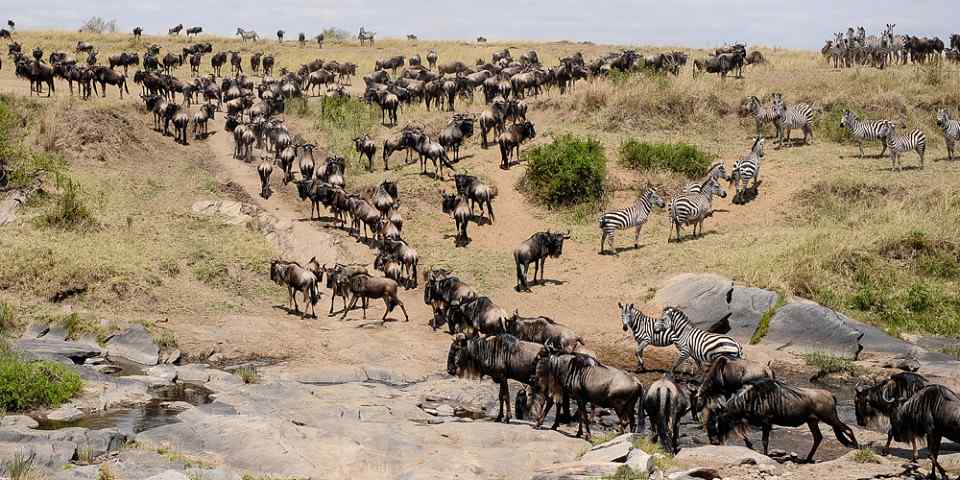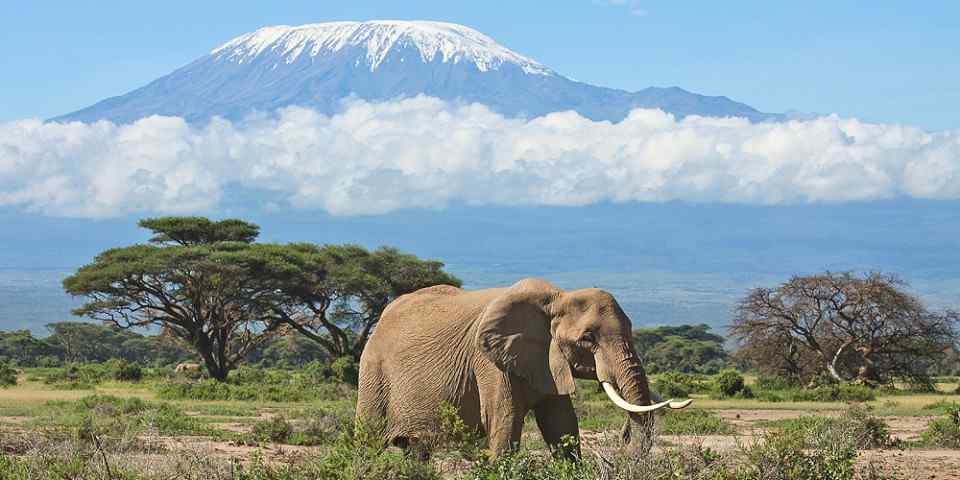Tour Length
Rates in USD $ – Change Currency
Per person, excl. international flightsOperator Rating
Other Tour Features
Filter by Operator
Filter by Accommodation
Kenya Safari Tours - Compare 2,666 Packages
Kenya is the historical home of the East African safari, a land of sweeping savannah grasslands inhabited by charismatic megafauna, including big cats, the Big Five (elephant, buffalo, lion, leopard and rhino) and just about everything in between. Elsewhere, landscapes here stir the soul with deserts in the north, dense forests in the west, Rift Valley lakes in the center and tropical coast out east. The result for those on safari is an experienced safari industry ready to show you a seemingly endless parade of wildlife against one of the most beautiful backdrops in Africa.
-
Top Rated Operator

6-Day Best Sopa Lodges Safari
$1,590 to $2,442 pp (USD)
Kenya: Private tour
Mid-range LodgeYou Visit: Nairobi (Start), Amboseli NP, Lake Nakuru NP, Masai Mara NR, Nairobi (End)

Meektrails Safaris
5.0/5 – 262 Reviews
-

8-Day The Best of Kenya Safari
$2,532 to $3,847 pp (USD)
Kenya: Private tour
Mid-range Lodge & Tented CampYou Visit: Nairobi (Start), Amboseli NP, Lake Naivasha (Naivasha), Lake Nakuru NP, Masai Mara NR, Nairobi (End)

Transtrek Safaris
4.9/5 – 122 Reviews
-

7-Day Best of Kenya Luxury Safari
$7,099 to $7,750 pp (USD)
Kenya: Private tourLuxuryLodge
You Visit: Nairobi (Start), Samburu NR, Masai Mara NR, Nairobi (End)

Wayfairer Travel
5.0/5 – 202 Reviews
-

6-Day Group Midrange Tour in Kenya
$1,873 to $2,071 pp (USD)
Kenya: Shared tour (max 8 people per vehicle)
Mid-range Lodge & Tented CampYou Visit: Nairobi (Start), Masai Mara NR, Lake Nakuru NP, Amboseli NP, Nairobi (End)

Viega Expeditions
4.6/5 – 17 Reviews
-
![3-Day Masai Mara Budget Safari Tour Kenya 2025- 2027]()
3-Day Masai Mara Budget Safari Tour Kenya 2025- 2027
$286 to $375 pp (USD)
Kenya: Shared tour (max 8 people per vehicle)BudgetTented Camp
You Visit: Nairobi (Start), Masai Mara NR, Nairobi (End)

Bienvenido Kenya Tours and Safaris
4.7/5 – 154 Reviews
-
![3-Day Masai Mara Wildlife Safari & Sundowners]()
3-Day Masai Mara Wildlife Safari & Sundowners
$1,456 to $1,926 pp (USD)
Kenya: Private tour
Mid-range Tented CampYou Visit: Nairobi (Start), Masai Mara NR, Mara River, Maasai Village (Cultural Village), Nairobi (End)

Samson’s Safaris
4.8/5 – 35 Reviews
-
Best Seller
![10-Day From Kenya to Tanzania - Mid-Range]()
10-Day From Kenya to Tanzania - Mid-Range
$5,240 to $6,370 pp (USD)
Kenya & Tanzania: Private tour
Mid-range Lodge & Tented CampYou Visit: Nairobi (Start), Lake Nakuru NP, Masai Mara NR, Serengeti NP, Ngorongoro Crater, Lake Manyara NP, Arusha (End)

Soul of Tanzania
4.9/5 – 531 Reviews
-
Top Rated Operator
![6-Day Highlights of Kenya and Tanzania - Luxury]()
6-Day Highlights of Kenya and Tanzania - Luxury
$3,900 to $4,870 pp (USD)
Kenya & Tanzania: Private tourLuxuryLodge & Tented Camp
You Visit: Nairobi (Start), Masai Mara NR, Serengeti NP, Ngorongoro Crater, Arusha (End)

Spirit of Kenya
5.0/5 – 634 Reviews
-
![3-Day Masai Mara Luxurious Private Safari from Nairobi]()
3-Day Masai Mara Luxurious Private Safari from Nairobi
$1,299 to $2,038 pp (USD)
Kenya: Private tourLuxuryLodge
You Visit: Nairobi (Start), Masai Mara NR, Nairobi (End)

Baby Bird Tours and Safaris
4.8/5 – 11 Reviews
-
![3-Day Romantic Maasai Mara Safari in a Private Jeep]()
3-Day Romantic Maasai Mara Safari in a Private Jeep
$980 to $1,756 pp (USD)
Kenya: Private tour
Mid-range Tented CampYou Visit: Nairobi (Start), Masai Mara NR, Nairobi (End)

Netherken Safaris & Tours
4.9/5 – 73 Reviews
-
![6-Day Ultimate Safari, Amboseli, Naivasha, Nakuru & Mara]()
6-Day Ultimate Safari, Amboseli, Naivasha, Nakuru & Mara
$2,066 to $3,382 pp (USD)
Kenya: Private tour
Mid-range Lodge & Tented CampYou Visit: Nairobi (Start), Amboseli NP, Lake Naivasha (Naivasha), Lake Nakuru NP, Masai Mara NR, Nairobi (End)

Bobu Africa
5.0/5 – 31 Reviews
-
![3-Day Masai Mara Game Safari]()
3-Day Masai Mara Game Safari
$1,011 to $1,800 pp (USD)
Kenya: Private tourLuxuryLodge
You Visit: Nairobi (Start), Masai Mara NR, Nairobi (End)

Personalized Tours and Safaris
5.0/5 – 10 Reviews
-
![3-Day Big Game Country Safari]()
3-Day Big Game Country Safari
$946 to $974 pp (USD)
Kenya: Private tour
Mid-range Tented CampYou Visit: Nairobi (Start), Amboseli NP, Nairobi (End)

KingTomondo Safaris Kenya
5.0/5 – 87 Reviews
-
Top Rated Operator
![4-Day Roaming Mara & Lake Nakuru Budget Camping Safari]()
4-Day Roaming Mara & Lake Nakuru Budget Camping Safari
$650 to $806 pp (USD)
Kenya: Shared tour (max 7 people per vehicle)BudgetTented Camp & Hotel
You Visit: Nairobi (Start), Masai Mara NR, Lake Nakuru NP, Nairobi (End)

Jungleroam Safaris
5.0/5 – 1,128 Reviews
-
Best Seller
![6-Day Masai Mara, Lake Nakuru & Amboseli]()
6-Day Masai Mara, Lake Nakuru & Amboseli
$1,265 to $1,573 pp (USD)
Kenya: Shared tour (max 8 people per vehicle)BudgetTented Camp & Hotel
You Visit: Nairobi (Start), Masai Mara NR, Lake Nakuru NP, Amboseli NP, Nairobi (End)

Keshi Tours
5.0/5 – 47 Reviews
-
![3-Day Safari from Mombasa to Tsavo East and Tsavo West]()
3-Day Safari from Mombasa to Tsavo East and Tsavo West
$1,008 to $1,176 pp (USD)
Kenya: Private tour
Mid-range Lodge & Tented CampYou Visit: Mombasa (Start), Tsavo East NP, Tsavo West NP, Mombasa (End)

Osnet Tours And Travels
4.7/5 – 39 Reviews
-
![3-Day Budget Safari to Masai Mara National Reserve]()
3-Day Budget Safari to Masai Mara National Reserve
$418 to $616 pp (USD)
Kenya: Shared tour (max 7 people per vehicle)BudgetTented Camp
You Visit: Nairobi (Start), Masai Mara NR, Nairobi (End)

Kenya Bush Expeditions
4.6/5 – 130 Reviews
-
![3-Day Tsavo, Taita Hills & Ziwani Sanctuary Coastal Tour]()
3-Day Tsavo, Taita Hills & Ziwani Sanctuary Coastal Tour
$868 to $1,064 pp (USD)
Kenya: Private tour
Mid-range Lodge & Tented CampYou Visit: Diani Beach (Start), Taita Hills WS, Ziwani, Diani Beach (End)

Kentau Safaris
4.9/5 – 80 Reviews
-
![3-Day Masai Mara Escape]()
3-Day Masai Mara Escape
$1,089 to $1,480 pp (USD)
Kenya: Private tour
Mid-range Tented CampYou Visit: Nairobi (Start), Masai Mara NR, Nairobi (End)

Msangai Adventure Safaris
4.7/5 – 126 Reviews
-
![6-Day Kenya Safari from Nakuru, Masai Mara to Amboseli]()
6-Day Kenya Safari from Nakuru, Masai Mara to Amboseli
$1,864 to $2,251 pp (USD)
Kenya: Private tour
Mid-range Lodge & Tented CampYou Visit: Nairobi (Start), Lake Nakuru NP, Masai Mara NR, Lake Naivasha (Naivasha), Amboseli NP, Nairobi (End)

Kipruto Safaris
4.9/5 – 8 Reviews
8 Questions About Kenya Safaris

Answered by
Anthony Ham
Anthony is a writer and photographer who co-writes Lonely Planet’s guide to Kenya, writes on the country for magazines and newspapers around the world, and has been exploring the country for more than a decade.› More about Anthony
8 Questions About Kenya Safaris
 Anthony Ham
Anthony Ham
When is the best time to visit Kenya?
“June to October is an excellent time for Kenya tours. During these months, the weather is generally dry (although it can get really hot in October and at the tail end of September) and most trails are open. This also coincides with the wildebeest and zebra migration in the Masai Mara National Reserve. This is the Dry season, and as it progresses, water sources for animals tend to dry up and become fewer, drawing animals in numbers to those that remain. One downside is that high-season prices apply during the Dry season months. Crowds are also larger – in some parks, the queue of safari vehicles can take away something from your experience, and some areas of the Masai Mara can be completely overwhelmed with vehicles during the migration. In the Dry season, June is one of my favorite months to visit. Visiting from November to February also has its devotees. At this time, migrating birds arrive, the rains rarely disrupt travel, and the country is transformed into a lovely shade of green. Most travelers avoid March to May because heavy rains are always possible and can transform safari trails into muddy bogs. That said, prices are lower and I visited once in April and was lucky to find very few other visitors (except for local visitors around Easter) and clear skies.”
1Why visit Kenya? What are the major attractions?
“Outstanding wildlife is the main reason to visit Kenya. While many visitors come for the migration, Kenya is excellent year-round, with a large number of world-class national parks – apart from the Masai Mara, there’s Amboseli, Lake Nakuru, Meru, Tsavo East and Tsavo West National Parks and Samburu National Reserve – where superb wildlife viewing is almost guaranteed. It all adds up to Kenyan safari possibilities of great variety. Kenya is Big Five territory, with healthy populations of elephant, buffalo, lion, leopard and rhino, but the birdlife is also outstanding, as is the cultural element – this is the land of the Maasai, Samburu, Turkana and others. The sheer number of habitats, too, make for wonderful scenery – endless horizons in the Masai Mara, tropical forests in Kakamega Forest National Reserve, the starkly beautiful parks of the north, and peerless Kilimanjaro views from Amboseli.”
2What does a Kenyan safari cost?
“It all depends on what sort of safari you want and can afford. Kenya has more variety than most other African safari destinations, with excellent options from the lower end of the pricing scale (from US$200 per person per day) to luxury Kenya safaris (up to US$1,000). While accommodation is partly what will determine the price for many travelers, it can also depend on how you wish to travel between the various parks. Air transfers, usually via Nairobi, can be expensive, but dramatically reduce the amount of time you’ll spend on the road, thereby maximizing the amount of time you’ll get to spend in the parks themselves. Remember also that most Kenya safari packages will include transport, accommodation, all meals and activities (including game drives).”
› Factors influencing the cost of a Kenya safari 3How is the wildlife viewing?
“It can vary from park to park. Most of the more popular parks that you can visit on a Kenya tour – Amboseli, Masai Mara, Samburu and Lake Nakuru – have fabulous wildlife-viewing opportunities. Dense wildlife populations in all of these parks make them good all-round safari destinations that enable you to see as many animals (and different species) as you can in a short period of time. Meru NP offers a wilder experience with fewer visitors but much the same wildlife. Other parks are more specialist – such as the birds and primates of Kakamega, and the sitatunga in Saiwa Swamp National Park – allowing you to tick off a hard-to-find species, usually without the crowds. And a more exclusive Kenyan safari experience is possible in the conservancies of Laikipia Plateau – you pay more, but, with the exception of Ol Pejeta Conservancy, crowds are non-existent and wildlife viewing is excellent. At most of these conservancies, you can get off-road as well, meaning that you’ll get a lot closer to the animals than you will in a national park.”
› More about viewing Kenya's wildlife and animals 4How safe is Kenya for tourists?
“For the most part, a Kenya safari is safe, but there are some important things to know. Nairobi and, to a lesser extent, some other Kenyan cities have a reputation for violent crime. I’ve spent a significant amount of time in Nairobi and elsewhere and have never once had a problem, but it does happen often enough to mean that you should always be careful and follow local advice when it comes to these cities. Another potential danger comes from traveling on the country’s roads – the accident rate is extremely high. You can minimize the danger by spending as little time as you can in Nairobi and other cities (in any case, Kenya’s charm rarely resides in its major urban centers), by never traveling at night and by flying between the parks. The danger from wild animals is minimal; most Kenya safari trips and operators have excellent safety records, and you should be fine if you follow the safety briefings and instructions from guides.”
5How do I select a reliable tour operator for a Kenyan safari?
“The best way to choose a Kenya safari is to read all about the safari experiences of other travelers at SafariBookings.com – chances are that their reviews will answer many of your questions (before you’ve asked them), as well as speak to the professionalism of the various operators with whom they’ve traveled. Otherwise, it’s extremely important that you contact any tour companies with whom you are considering traveling before you make a booking, and ask any questions you may have. This could be anything from the mode of transport, frequency of meals or daily safari schedules to the languages spoken by your guide or how many other travelers will be in your vehicle. Be as specific as you can. Not all operators offer customized Kenya tours, it’s true, but there’s no substitute for being informed. The operator’s willingness to answer questions can be a good guide to their dealings with people on safari.”
6What type of accommodation can I expect?
“As a general rule, the higher your Kenya safari prices, the better you can expect your accommodation to be. At the lower end, campsites are usually basic, sometimes crowded and not always in the best locations within the national parks or reserves, but they are well priced and often have ample facilities such as showers and toilets. Lodges are the mainstays of the Kenya safari scene and the quality varies considerably. Many lodges within the reserves and national parks have excellent locations but are aging and in need of renovation, while others are luxurious and recently overhauled. In tented camps, including mobile camps, you’ll sleep in large, walk-in tents – they’re like lodge rooms in terms of size but with canvas for walls and floor. Canvas tents mean that you can hear the sounds of the African night. Hopefully you won’t hear the sounds of your neighboring guests if the tents are nicely spaced. Most lodge rooms and tents of this kind have comfortable (not camp) beds, sometimes a desk and usually a private bathroom; some even have an outdoor shower with no roof but walls that protect your modesty. Particularly in tented camps, you’ll most likely need to recharge your devices not in your room but at a power station in the main public area.”
7What can I expect from a safari in Kenya?
“Most days out on safari begin with a quiet African voice waking you well before sunrise. After dressing quickly, and having a coffee or tea, you head out for a few hours in a safari vehicle (with other guests, a driver, guide and sometimes a tracker) looking for wildlife – this time, and the last hours before sunset, are ideal for viewing wildlife. You’ll return to the lodge or camp mid- to late morning for a proper sit-down breakfast. A few hours of relaxation, followed by lunch, then a few hours more doing very little occupies the hottest part of the day, when even animals retreat into the shade. Afternoon tea, often known as High Tea in a nod to colonial-era safari traditions, happens around 3 PM or 3:30 PM, then it’s back out looking for wildlife until after dark. Just before sunset, you’ll stop for another safari institution, the ‘Sundowner’, when you’ll watch the sunset while nursing the drink of your choice. You arrive back in camp in time to freshen up, then it’s dinner and off to bed, before it all starts again very early the next morning.”
8Kenya Safari Reviews

Stuart is a travel writer and author of numerous Lonely Planet guidebooks, including 'Kenya', 'Rwanda' and 'Tanzania'.
East Africa’s Most Varied Nation
Kenya is the original home of the safari. This is the land of the world-renowned Masai Mara National Reserve where tawny coloured lions feast off the hundreds of thousands of wildebeest that annually migrate into the country from...

Alan is a travel writer and author of over 20 Lonely Planet guidebooks, including the guides to Southern Africa and Zambia & Malawi.
A Safari Behemoth
In some ways, Kenya rates as the best country for safaris in Africa. That is a contentious statement and many would argue that Tanzania should be given that title. Whichever way you go, Kenya is undeniably a destination that will fulfill...
 NL
NL
Experience African life
Kenia offers the possiblity to experience African (wild) life in many aspects. The different nature reserves present different landscapes and a variety of wild life. While travelling from one park to the other you get an impression of the...
A once in a lifetime experience
For those looking to check off another item off their bucket list and to see a Safari as it is meant to be, I highly recommend going to Kenya. From the first camp to the last, it’s like walking onto a movie set. The picturesque views and...
 IT
IT
Marvellous
I visited Kenya after ten good years must say Kenya is a developed and developing country..the people are so welcoming smiles ..the ease of living is top tier .the weather was good food was excellent i mean just loved everything
 AT
AT
Wildlife on safari top - nationalparc fees flop !!
Our safari in Kenya was very varied and fantastic. The safari company African Hartebeest booked according to our wishes and delivered what it promised. I can definitely recommend this small company. The website safaribookings is very...






















_4485_5e46fe3202424.gif)










